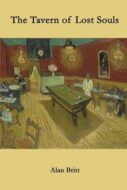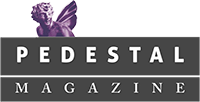 The Tavern of Lost Souls
The Tavern of Lost Souls
Alan Britt
Červená Barva Press
Reviewer: David E. Poston
It has been fifty years since Mantras: An Anthology of Immanentist Poetry, edited by Alan Britt, first appeared. Britt has now published twenty-five collections of his own poetry, with The Tavern of Lost Souls being one of two that came out in 2023. His work has been widely translated and anthologized, and the list of contemporary poets whom he mentions, quotes, or offers appreciation in this volume shows clearly how well he is connected with the global poetry community. And not just his contemporaries; the poems in this book highlight his affinities with Baudelaire, Rimbaud, Neruda, Vincente Aleixandre, Blake, and Lorca.
All that tells us something about where Alan Britt has been, but what do these poems tell us about where he is?
The opening poem wastes no time pulling us into the moment: “Now I’m going to tempt my bones / with this Chablis.” Addressing the gnats that circle him in his garden, the speaker assigns them a “passionate nature” and an “immanentist lifestyle,” adding “I believe you possess / a Rimbaudian sensibility.” Throughout this collection, Britt positions us between the moment and eternity, between the “garden about to explode” and “laurels / spanning 12,000 generations.”
The influences of dadaism, surrealism, and the French Symbolists are clear and pervasive. In the poem “Jules Laforgue,” Britt says,
I first remember riding with Jules
in his white ’67 Corvair;
that’s when I discovered him
cruising South Dixie Highway
at speeds I’m no longer proud of.
Laforgue, the Franco-Uruguayan Symbolist poet, died in 1887 (at age 27, like a rock star), but his presence and influence remain in Britt’s poesy.
That poesy is one in which metaphors are piled upon similes, in which “we caress destiny’s purple hips / swaying like giant eggplants in the June garden.” Although the physical world is lushly present—eggplants, sea grapes, laurels, parrotfish, scarlet tanagers, cicadas, sweet Yellow Tail Shiraz—these poems exist for themselves, using language that transcends the tired and debased language of “those environmentally controlled regions of consciousness” heard on the national news or in the Chamber of Commerce or “the bourgeois suburbs of New Orleans.” As “Bringing Pablo Home from a Secondhand Bookshop” describes it,
Somehow these words
look backwards,
forwards
and to both sides
illuminating lives, deconstructing epiphanies,
while launching satellites into our mysterious universe.
The language is alive and audacious. “Christmas Poem, 2002,” for example, begins with “Blade of sunlight through Shiraz / ignites flamenco hips.” “Thinking about Illusions” concludes with:
A male cardinal injects morphine
into the late afternoon’s jade shoulder,
followed by six drops of mercury carving rivers
below the Christian icon’s paint-peeled eyes.
“Communal Love” is dedicated to Romanian poet Ruxandra Cesereanu, and its conclusion references her poem “the flower girl,” in which Cesereanu writes “death can only be a man mature with a tarnished sex / the flower girl in me can’t wait to fall into bed with him.” In Britt’s poem, as the guitarist plays with his tarantula fingers,
… the mistress
enters the subterranean bar
with a swagger
and melting stars on her shoulders.
Death looks her straight in her eyes
and she doesn’t even flinch.
The poems throughout this collection have that unflinching swagger to them.
“Poem that Begins with a Pink Neon Hand Blinking in a Fortune Teller’s Window” uses as its epigraph the concluding lines of Miguel Hernández’s “The World Is as It Appears,” lines which mourn how we are paradoxically blinded by the world around us from seeing what really matters. “Why is the shallow life more enticing than reading Merwin and Donne?” the poem asks. It goes on to describe the pink neon hand pried loose by “the real estate financier” and left shattered on the sidewalk. The poem concludes,
So, that is how art is born, by accident,
by cruelty, by greed, by crushing each
of the pulsating pink neon fingers
until only one finger remains
blinking, blinking, blinking.
In the full context of this collection, I read those lines not as a resignation, but as a rallying cry.
“Truth in Symbolism” is certainly a rallying cry as well, describing how it was the symbols on the flanks of the Native Americans’ horses that won the day at Little Big Horn, as “Crazy Horse was already yelling at the government / the way Allen Ginsberg would / almost 100 years later.” Britt continues, “As a matter of fact, / symbols win almost every time.” The poem concludes with this defiant refusal to concede:
You see symbols are an endangered species.
Some even believe they have their side
of the fence and should learn
to stay in their yard,
as Robert Frost suggested
almost 100 years ago.
But there’s still time, I say, to pay attention
to the most symbolic thinkers
of our generation—
our poets.
In “The Dark Horse,” we see clearly how Alan Britt has come to trust his vision, even as the poem begins by expressing doubt in that vision. The speaker describes being “rudely / elbowed/ in the ribs / when your guitar / rode past / on its cloudy Leipzig stallion,” and thinking himself a half-crazy dreamer. Yet the poem concludes,
I’ve learned that if you fondle the flowing walnut hair
of verbs paled by whale oil long enough,
you’ll discover
imagination
to be a welcome source
of illumination
while tunneling the hideous intestines
of enlightenment.
As theologian N. T. Wright has famously pointed out, the Enlightenment has led to both penicillin and Hiroshima—both great scientific advances and horrible cruelties—so I take those last two lines as vital to having a full appreciation of this collection and the aesthetic tradition it embodies.
In the title poem, Britt writes,
I carry the shadow
of Nagasaki
in my walk.
However, my true agenda
is not cruelty.
His true agenda is introduced in the poem’s concluding stanza, when the guitarist—shabby, scarred, hobbling—“saunters into the tavern of lost souls.” The poem leaves us to imagine what he plays; the point is that Britt trusts that his readers still have the capacity to imagine that music and song (think of Coleridge’s damsel with a dulcimer, if you will), if we tune out the grubby and grasping world around us.
Perhaps this passage from “The News as It Is Today, June 13, 2003” tells us where Alan Britt is in 2023:
I believe one day, when thunder becomes symbolic again,
then and only then we’ll discover
the true nature of existence,
heralded by trumpets, snare drums and guitars lit like green fuses,
plus lusty violins with the wings of palmetto bugs,
and Seminole artists pressing mystical tiles into the walls
of North Palm Beach seafood restaurants,
or from a high school, Baltimore County,
a ghostly-pallored student
writing poems that dream of breaking
the sound barrier—
all these and more could erupt
into one glorious moment …
We need Alan Britt to keep believing that and to keep encouraging us to believe it.

